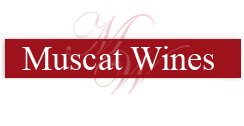MUSCAT WINES OF ITALY
In addition to being one of Europe’s most important wine producing countries, Italy is one of the oldest. Grapes were cultivated by the Etruscans in the 8th century BC. Muscat wines have been part of the Italian wine scene for centuries. There is conjecture that Sicily’s “Muscato di Noto” is the ancient wine “Pollio” to which Pliny the Elder referred when he wrote that it “is born on Sicily and has the flavor of must”.
The Muscat grape most commonly grown in Italy is Moscato Bianco. It is the fourth most commonly grown white wine grape in the country and is cited in 17 Italian DOCs. This aromatic grape produces wines that are characterized by floral aromas with peach and citrus overtones. It is widely used in Italy for lightly sparkling, or Frizzante wines, the most famous of which are Asti Spumante and Moscato d’Asti from Piedmont. Most of the non-sparkling Italian Muscats can be categorized as having varying degrees of sweetness. The strongest and sweetest Muscats are the specially made “Passito” and “Liquoroso” wines. The most notable exceptions to all this “sweetness” are Muscat de Chambave from the Aosta Valley which is an ancient and impeccably made dry table wine and the drier, crisper Muscats from the Trentino region.
In Trentino-Alto Adige some very special Muscat wines are made from differently colored variants of Muscato Bianco. Moscato Rosa is pink berried with aromas of roses and Moscato Giallo (also called Fior d’Arancio) is yellow berried with aromas of orange blossoms. Both these grapes produce light bodied richly scented wines. They are the only wines of the region that can be produced either sweet or dry. Many consider the sweet versions to be extraordinary.
Muscat of Alexandria (Zibibbo) is used to produce the famous Sicilian Moscato di Pantelleria wines (including Passito, Liquoroso, and Dolce verisons). Moscato Rosa is used to make light sweet wines especially in the Fruili-Venezia and Trentino-Alto Adige regions.
AOSTA VALLEY
Moscato Bianco, known as Muscat Chambave or Chambave, is made into exotic fruity wines that can be either dry or sweet called Chambave Muscat or Nus Muscat. (Chambave and Nus are geographically designated DOC sub-zones.) Passito di Chambave is also available in very limited production
CALABRIA
Muscats are widely produced, sometimes in a passito style.
Cantine Viola
Moscato Passito Calabria IGT
Luigi Viola
Moscato Passito 2007 (Winner Tre Bicchieri Award 2008)
EMILIA ROMAGNA
A small amount of Moscato is produced in this region.
Lini 910
Moscato Spumante
FRUILI-VENEZIA GIULIA
Moscato Rosa is used to produce a lightly sweet wine.
Jermann (Vigna Bellina)
Moscato Rosa
Marco Felluga
Moscato Rosa
LOMBARDY
There is a variety of Moscato wines made in this region: passito, spumante and fortified sweet wines.
La Brugherate
Moscato di Scanzo
A rarity from Bergamo. A tawny dessert wine.
PIEDMONT
Moscato Blanco grapes are cultivated from the Asti area south into the Barbaresco zone.
Asti Spumante
Also known as Asti , a justly famous sweet sparkling wine made around the town of Asti. Low in alcohol with the flavors of ripe green grapes and sugared almonds.
Producers:
Bera
Bonardi
Cinzano
Contratto
Fontanafredda
Gancia
Martini
Rosso
Moscato d’Asti
Made from the same Moscato Bianco as Asti and in the same region. It is less fizzy than Asti with a fresh citrus taste. Many wine drinkers consider it to be superior to Asti Spumonte.
Producers:
• Bera
• Ca d’Gal
• Cascina Castle’t (Maria Borio)
• Cascina Fonda
• Caudrina
• Ceretto ( I Vignaioli di Santo Stefano)
• Chiarlo, Michelle. NIVOLE. Increasingly famous winery
• Il Falchetto
• La Spinetta
• Rivetti
• Saracco Paolo. One of the top producers.
• Scagliola
• Soria.
• Cascinetta.
Moscato Naturale d’Asti
Still or only slightly fizzy. Drink young.
Moscatos di Strevi
Straw yellow in colour with musky, grapey perfumes Produced in a sparkling form or as a passito wine.
Producers:
Banfi (Sparkling)
Domenico Ivaldi, Casarito (passito wine)
Loazzolo
• A sub DOC within the Asti zone produces Moscato wines in the passito style.
Other passito producers include:
Batasiolo
I Vignaioli di San Stefano Belbo
PUGLIA
Moscato di Trani
A rare Muscat that takes its name from the Trani viticultural zone in the province of Bari. Moscato di Trani is made almost exclusively
SARDINIA
Sardinia produces a number of fortified Moscato wines
SICILY
It is the custom to drink Moscato wine on April 13, the feast day of St. Martin.
Moscato di Pantelleria DOC)
Moscato has been made on the island of Pantelleria for centuries. It has been described as being delicate with a sweet, enticing flavor.
Moscato Passito di Pantelleria (DOC)
Made from Zibibbio grapes (Muscat of Alexandria). The traditional way to make passito wines involved picking the grapes and placing them on a mat. They dry in the sun during the day and are covered at night. As the grapes dehydrate, their juice becomes increasingly sweet.
Moscato di Noto (DOC)
Produced in limited quantity this wine was developed in the Experimental Winery in Noto, a commune in Syracuse with the objective of developing a quality Moscato wine that could be drunk young.
Moscato di Siracusa (DOC)
An ancient Sicilian wine that has not been in production since 1983.
TRENTINO-ALTO ADIGE
Most of the sweet wines are Muscats either Moscato Rosa (Rosenmuskatateller) or Moscato Giallo (Goldenmuskateller) which may have been brought north from Sicily in the late 19th century. In order to make sweet wine the grapes are harvested late in October. Moscato Rosa is characterized by an aroma of roses. Some versions are fortified.
TUSCANY
Moscadello di Montalcino (DOC). Moscadello, the original strain of Muscat in Montalcino, is making a comeback. The wine is soft and delicate and should be consumed within a year of the harvest.
VENETO
Fior d’Arancio Moscato
Wine from Colli Euganei with a light yellow color and citrus scents produced in spumante or passito versions.
Moscato Giallo
Produced close to Lake Garda
